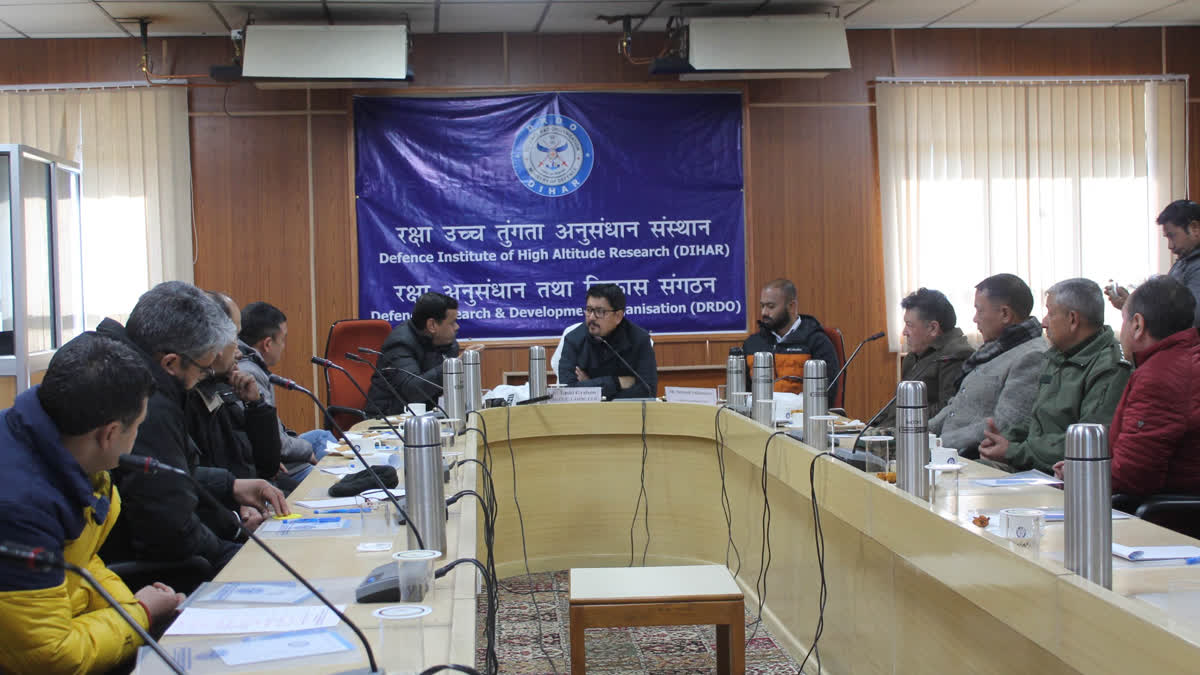Leh: The Defence Institute of High Altitude Research (DIHAR), under the Defence Research and Development Organisation (DRDO), organised a special programme to contribute towards achieving a 'Carbon Neutral' Ladakh by promoting sustainable and energy-efficient heating solutions for the region.
The programme, Solar Thermal Technology-Based Space Heating Systems, was held at DIHAR's administrative block in Leh.
Speaking on the occasion, Dr OP Chaurasia, director of DIHAR, said, “The main objective is to leverage solar thermal technology for space heating, especially to warm houses during winter, when heating is a major challenge whereas summer conditions are more favourable. During summer, temperature rises above 30°C, while in winter, it plummets to minus 30°C. Ladakh is unique in India as it experiences such extreme and contrasting temperature variations. Despite these challenges, Ladakh is blessed with abundant sunshine, making it one of the best places in India to harness solar energy. Globally, there are only a few regions where solar intensity is as high as it is here. We have collected solar data for the past 25 years, which confirms that Ladakh has excellent Direct Normal Irradiation (DNI), ideal for solar thermal technology".
He further said that the solar technology is based on evacuated tube collectors, widely known across India for solar water heating. "A few years ago, we decided to adapt this technology for solar thermal applications. We conducted a small study involving two rooms, which proved successful. Building on this success, we extended the application to our administrative block,” he said.
Congratulating the team, chief guest, Adv. Tashi Gyaltson, chief executive councillor, Leh, said, “The technological innovation by DIHAR is commendable and holds great potential for space heating. This apart, we are also experimenting with and promoting geothermal energy. If we can further refine this technology for domestic heating systems, it will greatly benefit the local population. We aim to provide subsidies for products that harness solar energy, enabling people to reduce their electricity bills while decreasing reliance on electricity imports. With the upcoming 13 GW solar power project in Leh, we are poised to achieve a surplus in energy production, making Ladakh one of the richest regions in India in terms of energy resources. DIHAR’s contributions extend beyond defence, they have significantly supported the overall development of Ladakh, offering valuable assistance across various sectors. Ladakh has the opportunity to set an example for the world and contribute to the Prime Minister’s mission of making Ladakh a carbon-neutral region.”
Gyaltson said a pilot project has already been installed at Bal Ashram in Leh, which has the potential to be a game-changer while stressing on the importance of improving insulation in government buildings along with directing all departmental heads to prioritise insulation efforts. He emphasised that Detailed Project Reports (DPRs) should be thoroughly vetted to ensure effective implementation.
Engineer, Sarfraz Nazir gave a presentation on the technology and functioning of the solar thermal-based space heating system.
Nazir said, “Previously, we used a diesel-based boiler water heating system to maintain the temperature in the administrative block. In 2023, we replaced it with a new solar thermal technology-based system, which has been fully operational since January. Globally, energy consumption is on the rise, with major requirements focused on power generation and the heating or cooling of buildings. Notably, maintaining habitable temperatures accounts for 32% of energy consumption worldwide. Ladakh, being a high-altitude, cold, mountainous region, experiences extreme temperatures, with some pockets recording as low as -40°C."
“In this region, energy consumption for maintaining indoor temperatures alone accounts for approximately 65–70%. However, the region has immense potential for utilising renewable energy sources such as solar, wind, hydro, and geothermal energy. Solar energy, in particular, is abundant, with long sunshine durations and a high number of cloud-free days. The average solar radiance here is 7.5–8 kWh/m²/day, the average annual sunshine duration is 7.9 hours per day, and there are around 300 cloud-free days per year.”
Santosh Sukhadeve, deputy commissioner, Leh and district officials were present at the programme. A group discussion was also held where stakeholders deliberated on the adoption and scalability of solar thermal technology



